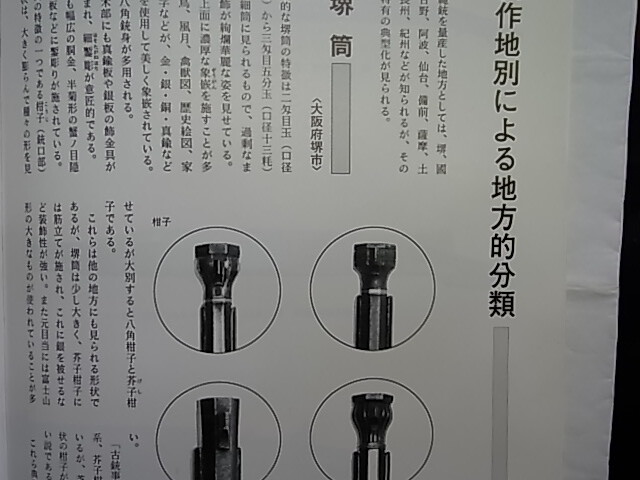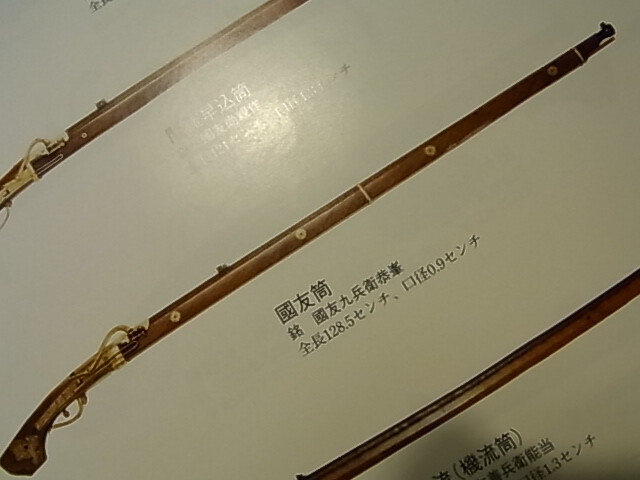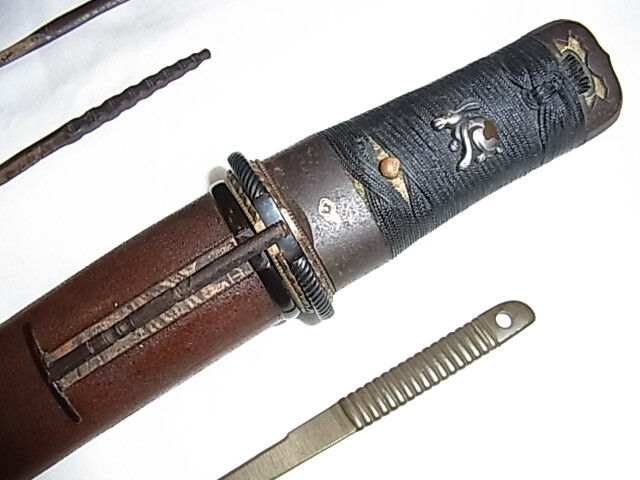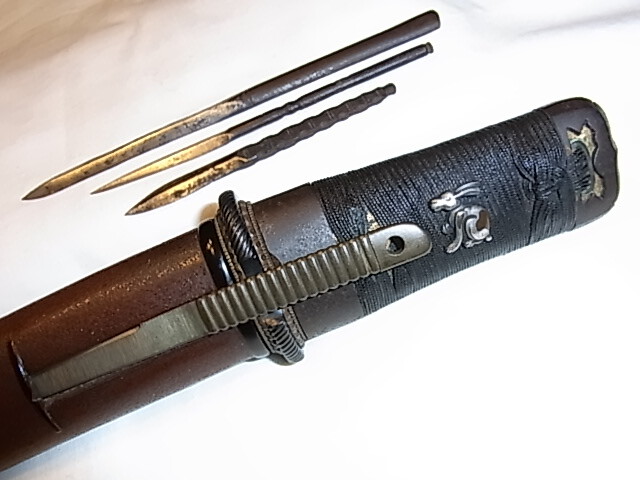-
Posts
14,054 -
Joined
-
Last visited
-
Days Won
257
Content Type
Profiles
Forums
Events
Store
Downloads
Gallery
Everything posted by Bugyotsuji
-
Hi Ron, some quick thoughts regarding your points above. 1. Yours are very deep. Mine is shallower. I am beginning to wonder whether the original straight-through hole was under-used and someone tried blocking it with whatever, and then they disovered you could get away with half the hole and half the decorations (= half the labor/labour) during manufacture. This may explain why there is so little literature on this feature, and only later guns seem to have it in this form. 2. From personal observation I agree that it is located in an inconvenient place for me, especially when my hands are full of other clobber. The other side would be better. Our matches are seriously hot however, and even with a large dollop of spit you would have to have very horny hands to avoid getting burnt. You would then have the problem of relighting if such became suddenly necessary. 3.About the angled hole you mention, my long gun has two of these in parallel. These holes would be the ones mentioned in the line above the line quoted, in the description web page. 火縄通しの穴 有無、材質、内径、飾り金具 = matchcord tunnel(s), presence/absence of, material(s) inner diameter, decorative metalwork I have used these in the past to push the matchcord through, though I am not yet convinced that the angle of them points consciously (decoratively perhaps) towards the Hachimanza. 4. Granted, depending on the other factors. 5. My Kumamoto Castle gun, definitely a combat gun, but of late vintage (1847) has this half-hole, but ringed only once in plain but thick brass. The inner end is wood, so I am burning the stock a little more each time I use it! Is that why yours are deeper, thru much use??? 6. OK 7. As you see, I did say that his work is not definitive. Agreed. I don't think anyone has yet had this debate anywhere so I am glad we are having it here.
-
Before I answer your detailed post above Ron, I just want to put this up before I forget it. (Old age) This 'NAMAE' site, based in Kamakura, is a site that lists for descriptive purposes the names for all the parts of the Tanegashima, and in 'The Stock', section 3 from the top, line 16, you can find this line: 火縄消しの穴 火消壷 有無、材質、内径、深さ、飾り金具(段数) = Match extinguish hole, fire extinguish hole, absence/presence of, material(s), inner diameter, depth, decorative metalwork (number of Dan) This comes from the following page. (In Japanese, sorry) http://www.geocities.jp/nosuka02/NAMAE.html
-
Concerning the use of the decorated cavity/half-hole I cannot say that my teacher told me this was for extinguishing the Hinawa. All my instincts and training tell me this has to be the purpose, although I grant that when displaying the gun a short section of match fed into this hole might be a good way to display it. The problem is that it would fall out immediately if you tried to use it like that. Some older guns have a hole that goes straight through, but this shallow hole would mean use of a very short cord, which would make little sense in battle, I am sure you would agree. The cord is always wrapped around the left forearm and gradually fed to the serpentine, through the diagonal hole as you suggest when it is present. When we finish our displays there is always an urgent message flashed around to extinguish our matches. They were precious in olden times I would guess. Some of our members carry a pair of scissors, but I have found the easiest and quickest way to comply is to push it in and suffocate the cord within this close-fitting metal-lined hollow. On p 18 of Sugawa san's pdf he calls this an extinguishing hole, ie Hi-keshi-no-ana 火消しの孔 http://www.mlsa.jp/sugawa/hinawajyu3.pdf This is by no means definitive, but I would like to go away and toss this around a little more and gather a few more grizzled opinions if I may, Ron. PS Here is a further selection of Sakai muzzles. PPS Your gun also has influences of Sendai in it! (The trigger etc.)(Or am I beginning to see things?) :lol:
-
In the records of gunsmiths there is 国友平八国安 甲斐国住 享和三年 国友鳳澤舎国安 甲斐住 There are also a couple of smiths listed not under Kunitomo, but like this: 鳳澤国重 甲斐住 鳳澤金平左衛門国重 甲斐住 鳳澤舎 国久 甲斐住 Those are all the recorded smiths of this school (?) that I can find.
-
Ah, that's a good idea. Thank you! This? http://www.city.otsuki.yamanashi.jp/17/ ... a/081.html
-
PPS I cannot yet find any record of a "Kuniyasu" gunsmith listed for Settsu-no-kuni Sakai, BTW. Here is an example of a Kunitomo gun with some similarities to yours, Ron, for reference.
-
Ron, the signature is quite interesting, but I think whoever took the photos must have missed the first characters for Kunitomo, which made my search a bit longer!!! All you have posted seems to be: First I found that the Mei Ho-sawa is recorded in a list of gunsmiths in Ko-shu 甲州 (甲斐)the present-day Yamanashi Ken, whence Takeda Shingen came. The third character has the meaning of Yadoru, 'temporarily living', or 'temporary abode'. Later following a few hours searching (!) I found that Kuniyasu is listed as a Kunitomo smith, but was he temporarily living in Yamanashi when he made this gun? The full signature should therefore be Kunitomo Ho-sawa (-zawa) Sha/Yadoru/Mi-o-yoseru/kari-ni-sumu Kuniyasu Saku, right? Admittedly the gun looks like a Sakai-zutsu, but being in fierce rivalry with each other , many Sakai and Kunitomo guns were almost indistinguishable. It may be that your gun looks restrained because it is in fact a Kunitomo gun, which were not generally as flashy/bling, or ostentatious as you say, as Sakai. PS I think you'll find the Chrysanthemum is an ashtray, for extinguishing the matchcord after use.
-
Thank you for showing your Tanto. Funny, it is fairly similar in some aspects to one that I have. Congratulations!
-
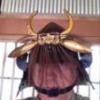
Not Nihonto but it is Samurai
Bugyotsuji replied to jason_mazzy's topic in Auctions and Online Sales or Sellers
Lorenzo, some amazing stuff in those links. What is the FONDAZIONE ANTONIO MAZZOTTA? -

Not Nihonto but it is Samurai
Bugyotsuji replied to jason_mazzy's topic in Auctions and Online Sales or Sellers
...scales drop off the eyes of your understanding, Ian? I don't believe you have any left! :lol: -

Please identify this if it is japanese
Bugyotsuji replied to jason_mazzy's topic in Auctions and Online Sales or Sellers
Oops, sorry, clicked on the second, but didn't look at the first link! -

Please identify this if it is japanese
Bugyotsuji replied to jason_mazzy's topic in Auctions and Online Sales or Sellers
No information given, so hard to judge exacty when and why these were made. We can surely say that they are however Japanese style. -
Well, no. I took it to a Kinko to see what he could do, but the result was not at all what I had expected. I wanted it perfect, just like before...
-
Thanks. Please do not ask me about the Tsuba, Philip. I went through a crazy patch buying Tsuba on internet auctions, in fairs, anywhere I found anything seemingly suitable. This one was not cheap, but perfect, in copper with a Shakudo finish and a nice twisted edge. It had no sekigane in the central Nakago Hitsu, so I cut up some copper sheet and folded and pushed it into the corners and adjusted the Tsuba to fit tightly over the Nakago. Or so I thought I was doing until I slipped with the tool I was using and put a deep scratch right across the Tsuba face...
-
Some bonus shots showing how the other small Bashin all sit happily there. I have reluctantly concluded that this slot was never originally designed for a Kozuka/Kogatana of the specially narrow width I had been searching for. To try to fit it would mean a redesign of the slot, and could lead to a split and more trouble than I need.
-
These are the candidates for the Hitsu side slot. The Kogatana/Kozuka is a solid piece of shibuichi, and suddenly seemed to be the perfect solution. The three Bashin are tetsu. The slot is triangular in cross-section. Hard to see because the horn entrance has been rather nibbled away. The Bashin all slide in easily. The Kozuka/Kogatana would break the Hitsu if forced in.
-
Philip, here are a few explanatory shots. The first two are the general appearance of the Saya, with the Bashin in place. My original thought was that with the kogatana/kozuka missing, someone had, at some point in history, added a Bashin just to fill the side Hitsu.
-
Funny little realization this week. And a question at the end for anyone interested. The Tanto in this thread needed a narrow Kozuka for the Hitsu in the Saya. The Bashin is fine for a Kyushu saya, but it's ON THE WRONG SIDE, I was assured. Well, I have searched and asked everywhere for a kozuka, but no luck so far. Then the other day I was sorting through some bits and bobs and discovered that I already owned a 'brass' kozuka which held promise and had no other use. I took it round to an artisan and asked if he could make it a perfect fit for me. He looked at the Kozuka and said, "This is a very nice Shibuichi Kozuka!" :D Then he fitted it into the Hitsu and shook his head. "No, you see the little triangular roof there? This Hitsu is made originally specifically for a Bashin, and not for a Kozuka." It was true. Well, I took it home and pulled out my three little Bashin, of different sizes and styles. All three of them fit one way or another quite happily into the side Hitsu. Finally I have lost the urge/need to find a Kozuka for this Saya. Question. Is this a 'rare' left-handed or back-to-front Saya, or did Kyushu follow different rules as to which side a Kozuka/Kogai/Bashin fitted into the Saya?
-

Not Nihonto but it is Samurai
Bugyotsuji replied to jason_mazzy's topic in Auctions and Online Sales or Sellers
Very nice, Ian. BTW Does it have all four of the Shio-de triangular rope attachments? (Can see one and part of another in the first pic above.) -
Waki. Den. Aizu Michitoki... (I hope! )
-
It's just a note to remind the owner of what's inside the Kanteisho.
-
A pretty one there Ron. Hmmm... maybe we need a dedicated Yanone thread!


